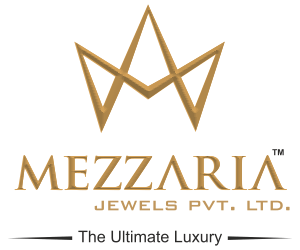
Diamond Education
The 4Cs of Diamonds
What difference can the cut of a diamond make? It's a question that deserves a detailed answer. Each cut we make in the creation of a diamond unlocks the beauty in the form of sparkle. The final effect is magic. Over generations, we at Mezzaria Jewels have focused on our craft, using artistry and science to improve the brilliance, and create more of the allure that attracts us.
The 4Cs
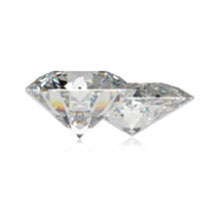
CUT
The cut grade indicates whether the diamond was cut to maximize sparkle.
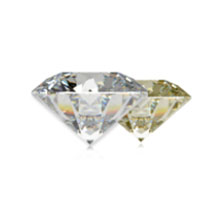
COLOR
This grade refers to the "whiteness" of a diamond, or its lack of color.
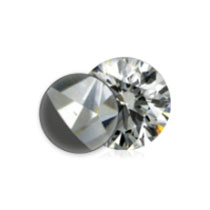
CLARITY
The clarity grade is based on only tiny natural identifiers found within a diamond.
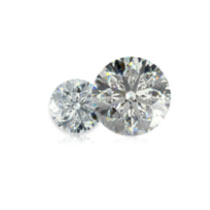
CARAT WEIGHT
This is a measure of a diamond's weight and a reflection of its size.
What is Cut?
The cut grade indicates how much a diamond will sparkle.
Cut refers to how perfectly the symmetry and proportions of the diamond capture light and then deliver it to the eye in the form of sparkle. If the diamond does not have exceptional proportions, or if the symmetry is off, the light will not travel through the diamond and return to the eye with maximum sparkle.
If you choose a diamond with a cut grade of Reserve Ideal or Ideal, you'll notice that it has more sparkle than diamonds with lower cut grades. If you're looking for a larger diamond within your budget, consider selecting a diamond with a Very Good cut grade, which will deliver amazing sparkle at a more affordable price. And if you want to maximize the size of your diamond, any Mezzaria Jewels with a cut grade of Good will still sparkle beautifully.
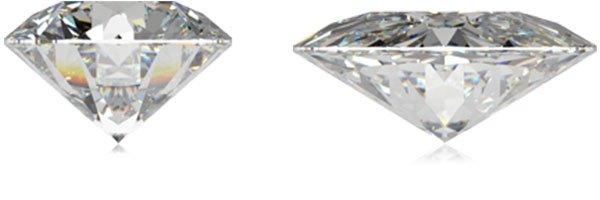
Cut Grade : Reserve Ideal, Ideal, Very Good, Good Smaller diamond More sparkle Perfect Polish
Cut Grade : Poor Visibly larger diamond Slightly less sparkle Very good polish
What is Color?
This grade refers to the "whiteness" of a diamond, or its lack of color.
Color is the characteristic of a diamond that is most easily detectable by the eye. Look at any Mezzaria Jewels, from D to J (colorless to near-colorless) and you wont notice any distracting color, just beautiful sparkle.
K and L graded diamonds are considered faint yellow. This means that, while still white diamonds, they reflect some secondary tones. These diamonds therefore look their most brilliant when set in yellow gold, which has a muting effect on the diamond’s faint yellow.
For an exceptionally white and colorless diamond, to be set in a white metal, consider those in grades D to F. Alternatively, grades G to J are almost invisible to the untrained eye.

Colorless
D E F

Near-Colorless
G H I J

Faint Yellow
K L
Mezzaria Jewels Does not Carry Diamonds of This Quality

Noticeable Color
M N O P Q R

Very Noticeable Color
S T U V W X Y Z
What is Clarity?
The clarity grade is based on any tiny natural identifiers found within a diamond.
It is very common for diamonds to be formed with slight imperfections. These are known as "inclusions" and can come in many forms, including tiny white points, dark dots, or feathery cracks. The fewer inclusions, the more the stone is worth. A diamond's clarity ranking is determined by the number, size, type and placement of the inclusions.
In order to grade the clarity of a diamond, it is necessary to observe the number and nature of any internal characteristics in the stone as well as their size and position. This Diamond Clarity Grading is carried out using the IGI scope and a loupe 10x under the experienced eye of laboratory gemologists. A diamond is said to be “Internally Flawless” when it presents no internal defects under 10x magnifications.
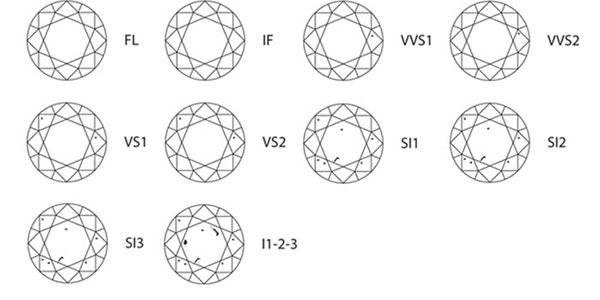
What is Carat Weight?
This is a measure of a diamond's weight and a reflection of its size.
Carat weight is exactly that — a weight measurement. But carat weight does not always clearly help you determine if one diamond looks larger than the next.
Consider that the carat weight of a diamond is the total weight, no matter how that weight is distributed. If a diamond is poorly cut and is tall and narrow, when viewed from the top that diamond will appear smaller than a diamond of equal weight. To eliminate this concern when shopping at Mezzaria Jewels, we do not offer any diamonds cut to maximize carat weight at the expense of sparkle.
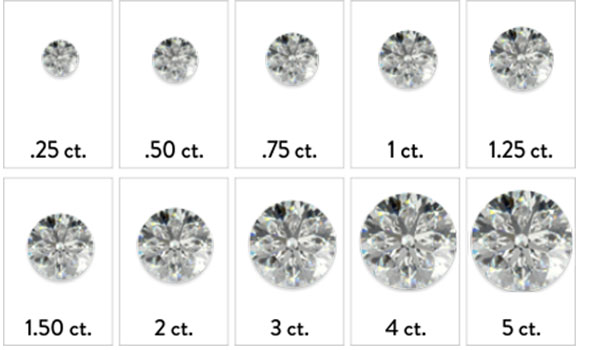
Gemologist's Tip
For the best value in carat weight, instead of choosing .50 carats, 1.0 carats, or 1.5 carats, etc., choose diamonds that weigh slightly less. You'll notice a significant price savings.
Best Practice Principle
The Mezzaria Jewels is taking the lead in introducing best practice principles to ensure the diamond industry is run in an ethical and professional way.
The Mezzaria Jewels is committed to abiding by these principles and is making it a condition of supplying all clients that they too agree to comply with them. Moreover the principles are formulated to ensure that Mezzaria Jewels and its customers encourage adherence to them at all levels of the supply chain down to the consumer. Mezzaria Jewels will also encourage industry organisations in the major diamond cutting centres to adopt these principles.
The implementation and monitoring of these Best Practice Principles will ensure consumers buying diamond jewellery will be able to rely with confidence on the ethical standards of the industry.
Consumer
We are committed to operating our businesses with a view to ensuring that consumers buying diamond jewellery are able to rely with confidence on the professional and ethical standards and technical skills of the gem diamond industry, taking account of the following :
- Natural diamonds are objects of prestige, a luxury good, generally acquired for sentimental reasons and are regarded as items of value by the consumer.
- Diamonds are a unique item about which the consumer has limited expertise and consequently, in order to make an informed choice, the consumer is reliant on (i) the standards and integrity of the diamond industry, and (ii) information from the diamond industry as to cut, colour, clarity and carat weight and other attributes, including the application of any treatment.
- The highest professional and ethical standards and technical skills are necessary to ensure that consumer trust is not misplaced and that the reputation of the gem diamond industry is maintained and enhanced.
- Consumers expect to purchase diamonds in their natural state, without any treatment, beyond the accepted skills of craftsmanship associated with their cutting and polishing and therefore the danger of non-disclosure of treatment of natural diamonds, and the passing off of partly or wholly synthetic diamonds and simulants as natural diamonds, is contrary to the interests of consumers.
- The injury and hardship suffered by local populations (and the potential for it) when conflicts arise in diamond producing areas are unacceptable, as is seeking to profit from such conflicts.
Business Practices
We are committed to operating our businesses in such a way that we neither engage in, nor encourage in any manner, the following practices which are regarded as unacceptable and against the public interest and that of the diamond industry :
- Buying and trading rough diamonds from areas where this would encourage or support conflict and human suffering.
- The use of child labour.
- Practices which intentionally or recklessly endanger or harm the health or welfare of individuals.
- Conduct which conflicts with the principles set out in (1) above, thereby bringing the diamond industry into serious disrepute.
Commitment
We are committed to the highest industry ethics including the following :
- Action to address concerns arising out of the misuse of rough diamonds in support of conflict and regular discussions on other issues relevant to the gem diamond industry to enable appropriate and timely industry responses.
- The provision of proper working conditions (including the health, safety and well-being of workers).
- The dignity of individuals and best practices to ensure the fair treatment of individuals.
- Full compliance with international best practice and the related regulatory framework with respect to the environment.
- Full disclosure at all levels of the diamond distribution chain and, most importantly, to consumers, of all treatments to natural diamonds and with respect to wholly or partly synthetic stones and compliance with the rules, regulations and guidelines published from time to time by the diamond industry’s governing bodies.
Ethical Sourcing
Beyond Conflict Free
Brilliant Earth goes above and beyond the current industry standards to guarantee that our diamonds originate from pure, ethical sources. We believe that high quality diamonds should not come at a great social and environmental cost.
Our ethically sourced diamonds originate from mines that adhere to strict labor, trade, and environmental standards. All of our center diamonds are traceable to their origins in Canada, Namibia, Russia, or Botswana.
Recycled Gold and Platinum
Dirty gold mining has a history of civil war, labor abuses, and environmental devastation. As part of our commitment to environmental responsibility, we handcraft all of our fine jewelry from recycled precious metals. Our objective is to diminish the negative impacts of dirty gold by reducing the demand for newly mined metals.
Brilliant Earth promotes the development of a fair trade gold system. This system will guarantee fair wages, promote economic growth, and empower mining communities. To demonstrate our support, we are now offering a stunning Fairmined gold collection.
Colored Gemstones
We offer our clients the option of having their jewellery made using recycled gold and platinum. This reduces demand for newly mined metals, diminishing the environmentally damaging effects of mining practices.
Once refined, recycled gold and platinum are of identical quality to (and therefore completely indistinguishable from) newly mined refined gold or platinum. For this reason, our refiner is independently audited and certified to guarantee that their metals really are 100% recycled.
Learn About Metals
Metals
Choosing the metal of your engagement ring is an important decision. Your engagement is the foundation of your future together, and the metal is the foundation of your engagement ring. Color, durability, care – these are the most important metal characteristics. While there are fads in jewelry metal color, this is a decision that will endure all trends. Consider the following details and you’ll make the right decision on the perfect ring.
Gold
Yellow gold offers a warm glow, and even white gold is a warmer white than metals like platinum or palladium. Pure gold is too soft to hold its shape in fine jewelry, so it's alloyed with other precious metals for strength. Look for "14k" or "18k" as a fineness mark that proves the quality of your gold jewelry. Among fine metals, gold tends to be more malleable, so prongs in a gold engagement ring should be checked each year with one of our Free In-Store Preview jewelers, and they can also re-plate white gold with Rhodium to bring it back to its original whiteness. To know what she'd prefer in an engagement ring, check the color of the metal jewelry she wears. If you choose a yellow gold ring, the color of the metal can make a near-colorless diamond and a colorless diamond look the same.
Platinum
Platinum is a strong, durable metal choice that does not fade over time. This makes it a symbolic option for engagement rings, as it will endure with your love. A hypoallergenic material, platinum is ideal for those with sensitive skin as it does not react with other elements. Its naturally white appearance makes it a popular alternative to white gold. Unlike white gold, however, it will not need replating over the years. Over time, it develops a stunning finish called a patina. This further protects your setting.
30 times more rare than gold, platinum is a wise choice for those looking for a truly unique and timeless engagement ring. Diamonds with color grades from D to F look particularly stunning set in platinum, complimenting their colorless quality.
Silver
Sterling silver makes a fine choice for jewelry. While sometimes considered traditional, silver has a more modern, stylistic feel than yellow gold. Depending on the design, silver jewelry can be classic or contemporary. Since pure silver is very soft and malleable, sterling silver is 92.5% pure silver; mixed with other metals such as copper, it forms an alloy. Mezzaria sterling silver is also rhodium plated. This means your silver jewelry will be stronger, less prone to damage, and more resistant to tarnish. If you do notice some tarnish, gently cleaning your silver with a polish and cloth will keep it looking immaculate. A stunning combination of strength and beauty, sterling silver is used to create incredible pieces that you’ll love wearing. It also complements most skin tones, making it a safe purchase for those needing to mark a special occasion.
Diamond Certification
Mezzaria Jewels are graded by the industry's most stringent diamond grading labs: AGSL and GIA. Each diamond available from Mezzaria Jewels comes with either a diamond grading report, diamond dossier®, or a diamond quality document.
The certified diamond experts at these diamond grading labs observe the diamond with their own expert eyes, as well as with a number of scientific tools to document the dimensions, color, clarity and carat weight of the diamond.
Diamond Grading Reports
Mezzaria Jewels only works with the most respected diamond grading labs. Because these labs have the highest standards for diamond grading, you'll find diamonds certified by these labs tend to carry a premium. Our diamonds have received the highest grades of quality, so they are guaranteed to be the highest quality diamonds available. The GIA, founded in 1931, established the standards for grading diamonds and provides gemologist training and supplies diamond knowledge to the industry today. The founder of the GIA went on to form the AGSL in 1934, to create a society of jewelers focused on consumer education and promoting ethical business practices within the diamond industry. in 1996 the AGS opened a diamond grading lab — the AGSL — a non-profit agency with the mission of providing stringent, standardized grading reports. Their mission is to establish a trusted set of criteria to evaluate diamond cut. This in turn, promotes the production of more diamonds cut for maximum sparkle, rather than cut to maximize carat weight.

© 2019 Mezzaria Jewels. All Rights Reserved.
Developed By : Gatisofttech
